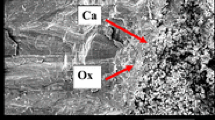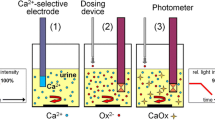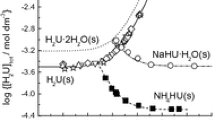Abstract
Kidney stone formation is governed by thermodynamic (supersaturation) and kinetic (crystal nucleation, growth, aggregation) mechanisms. We adopted a dual theoretical and experimental approach to investigate the potential role of urinary phytate in this regard. Thermodynamic constants for eight protonated phytate species and seven calcium–phytate complexes were determined by potentiometry and incorporated into the speciation program JESS. Urine was collected from 16 heathy males and their urine compositions were used as input for JESS. Phytate concentration was varied during modelling. No statistically significant decreases in Ca2+ concentrations or in supersaturation values were predicted by JESS. Crystallization experiments were then performed in pooled urine. Endogenous phytate concentration was determined using a metal–dye assay. The pool was dosed with various concentrations of phytate to achieve final concentrations equivalent to those used for modelling. Experiments showed that phytate had no effects on Ca2+ concentrations (as predicted by our theoretical modelling), metastable limits or crystal nucleation and growth kinetics. However, crystal aggregation kinetics was inhibited. We speculate that HPhy−11, small amounts of which were revealed by modelling, may bind to crystal surfaces and inhibit aggregation. We conclude that phytate exerts a kinetic, but not a thermodynamic inhibitory effect on crystallization in urine.




Similar content being viewed by others
References
Modlin M (1980) Urinary phosphorylated inositols and renal stone. Lancet 22:1113–1114
Curhan GC, Willett WC, Knight EL, Stampfer MJ (2004) Dietary factors and the risk of incident kidney stones in younger women: Nurses’ Health Study II. Arch Int Med 164(8):885–891
Grases F, March JG, Prieto RM, Simonet BM (2000) Urinary phytate in calcium oxalate stone formers and healthy people-dietary effects on phytate excretion. Scand J Urol Nephrol 34:162–164
Grases F, Isern B, Sanchis P, Perello J, Torres JJ, Costa-Bauza A (2007) Phytate acts as an inhibitor in formation of renal calculi. Front Biosci 12:2580–2587
Saw NK, Chow K, Rao PN, Kavanagh JP (2007) Effects of inositol hexaphosphate (phytate) on calcium binding, calcium oxalate crystallization and in vitro stone growth. J Urol 177:2366–2370
Gans P, O’Sullivan B (2000) GLEE, a new computer program for glass electrode Calibration. Talanta 51:33–37
Gans P, Sabatim A, Vacca A (1996) Investigation of equilibrium constants with the HYPERQUAD suite of programs. Talanta 43:1739–1753
Allie-Hamdulay S, Rodgers A (2005) Prophylactic and therapeutic properties of a sodium citrate preparation in the management of calcium oxalate urolthiasis: randomized, placebo-controlled trial. Urol Res 33:116–124
Schlemmer U, Frolich W, Prieto RM, Grases F (2009) Phytate in foods and significance in humans: food sources, intake, processing, bioavailability, protective role and analysis. Mol Nutr Food Res 53:s330
May PM, Murray K (1991) JESS, a joint expert speciation system-1. Talanta 38:1409–1417
Jappie D, Rodgers A (2000) Determination of the optimum number of subjects required for pooling urines: statistical approach. In: Rodgers AL, Hibbert BE, Hess B, Khan SR, Preminger GM (eds) Urolithiasis 2000 proc 9th Int Symp Urolithiasis, University of Cape Town, Cape Town, South Africa, pp 92
Costa-Bauza A, Grases F, Fakier S, Rodriguez A (2013) A novel metal-dye system for urinary phytate detection at micro-molar levels in rats. Anal Methods 5:3016–3022
Ryall RL, Hibberd CM, Marshall VR (1985) A method for studying inhibitory activity in whole urine. Urol Res 13:285–289
Hess B, Meinhardt U, Zipperle L, Giovanoli R, Jaeger P (1995) Simultaneous measurement of calcium oxalate crystal nucleation and aggregation: impact of various modifiers. Urol Res 23:231–238
Webber D, Rodgers AL, Sturrock ED (2007) Glycosylation of prothrombin fragment 1 Governs calcium oxalate crystal nucleation and aggregation, but not crystal growth. Urol Res 35:277–285
Pak CYC, Ohata M, Holt K (1975) Effect of disphosphonate on crystallization of calcium Oxalate in vitro. Kidney Int 7:154–160
Torres J, Dominguez S, Cerda MF, Obal G, Mederos A, Irvine RF et al (2005) Solution behaviour of myo-inositol hexakisphosphate in the presence of multivalent cations. Prediction of a neutral pentamagnesium species under cytosolic/nuclear conditions. J Inorg Biochem 99:828–840
Crea P, de Robertis A, de Stefano C, Sammartano S (2006) Speciation of phytate ion in aqueous solution. Sequestration of magnesium and calcium by phytate at different temperatures and ionic strengths, in NaCl. Biophys Chem 124:18–26
Crea F, Stefano CD, Milea D, Sammartano S (2008) Formation and stability of phytate complexes in solution. Coord Chem Rev 252:1108–1120
Li N, Wahlberg O (1989) Equilibrium constants of phytate ions. 2. Equilibrium between phytateions, sodium ions and protons in sodium perchlorate medium. Acta Chem Scand 43:401–406
Stefano CD, Milea D, Pettignano A, Sammartano S (2003) Speciation of phytate ion in aqueous solution. Alkali metal complex formation in different ionic media. Anal Bioanal Chem 376:1030–1040
Evans WJ, McCourtney EJ, Shrager RI (1982) Titrations of phytic acid. JAOCS 59:189–191
Crea F, Crea P, Stefano CD, Milea D, Sammartano S (2008) Speciation of phytate ion in aqueous solution. Protonation in CSCl(aq) at different ionic strengths and mixing effects in LiCl(aq) + CsCl(aq). J Mol Liq 138:76–83
Grases F, Kroupa M, Costa-Bauza A (1994) Studies on calcium oxalate monohydrate crystallization: influence of inhibitors. Urol Res 22:39–43
Grases F, March P (1989) A study about some phosphate derivatives as inhibitors of calcium oxalate growth. J Cryst Growth 96:993–995
Kavanagh JP (2006) In vitro calcium oxalate crystallisation methods. Urol Res 34:139–145
Hess B, Ryall RL, Kavanagh JP, Khan SR, Kok D, Rodgers AL et al (2001) Methods for measuring crystallisation in urolithiasis research: why, how and when. Eur Urol 40:220–230
Hess B, Kok DJ (1983) Nucleation, growth and aggregation. In: Coe FL, Favus MJ, Pak CYC, Parks JH, Preminger G (eds) Kidney stones: medical and surgical management. Lippincott-Raven Publishers, Philadelphia, pp 3–32
Finlayson B (1978) Physicochemical aspects of uroliths. Kidney Int 13:344–360
Finlayson B (1974) Renal lithiasis in review. Urol Clin N Am 1:181–212
Rose GA (1987) Current trends in urolithiasis research. In: Rous N (ed) Stone disease: diagnosis and management. Grune & Stratton, Inc, Orlando, pp 383–416
Saied N, Aider M (2014) Zeta potential and turbidimetry analyzes for the evaluation of chitosan/phytic acid complex formation. J Food Res 3:71–81
Fakier S (2015) The effect of inositol-hexakisphosphate (phytate) on urinary risk factors for calcium oxalate urolithiasis in South African population groups with different kidney stone risk profiles: theoretical modelling, in vitro crystallisation experiments and in vivo human studies (Doctoral dissertation, University of Cape Town)
Acknowledgements
Major sections of the work described in this paper are based on studies performed by the first author Saajidah Fakier as part of her Ph.D. thesis [33]. The authors wish to thank the South African National Research Foundation, the South African Medical Research Council and the University of Cape Town for financial support.
Author information
Authors and Affiliations
Corresponding author
Ethics declarations
Conflict of interest
The authors declare that they have no conflicts of interest.
Ethical approval
All procedures performed in human studies were approved by the Human Research Ethics Committee of the University of Cape Town (HREC REF: 072/2014) and were performed in accordance with the ethical standards of the 1964 Helsinki Declaration and its later amendments.
Informed consent
Informed consent was obtained from all individual participants included in the study.
Additional information
Publisher’s Note
Springer Nature remains neutral with regard to jurisdictional claims in published maps and institutional affiliations.
Electronic supplementary material
Below is the link to the electronic supplementary material.
Rights and permissions
About this article
Cite this article
Fakier, S., Rodgers, A. & Jackson, G. Potential thermodynamic and kinetic roles of phytate as an inhibitor of kidney stone formation: theoretical modelling and crystallization experiments. Urolithiasis 47, 493–502 (2019). https://doi.org/10.1007/s00240-019-01117-1
Received:
Accepted:
Published:
Issue Date:
DOI: https://doi.org/10.1007/s00240-019-01117-1




